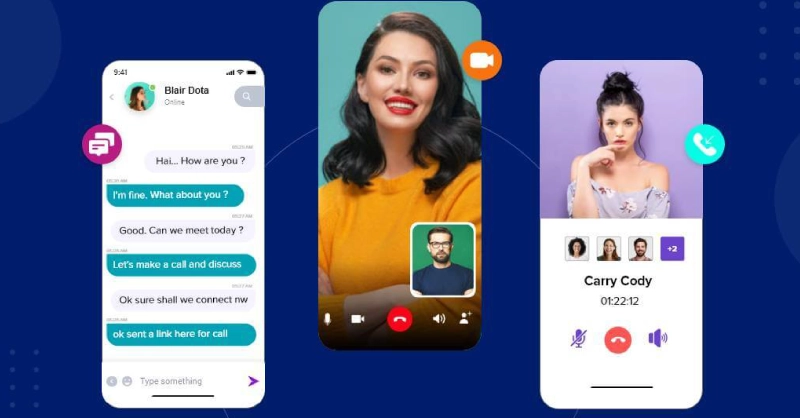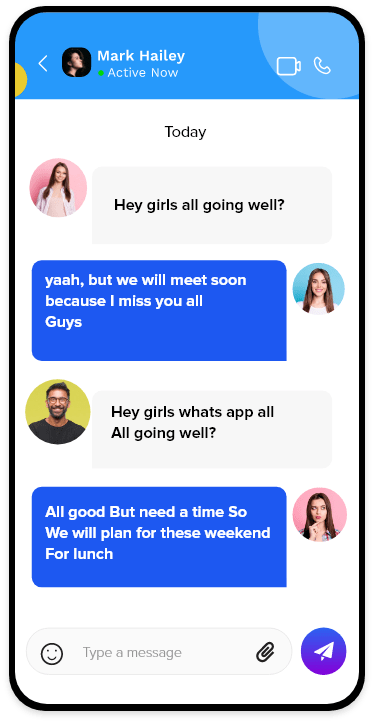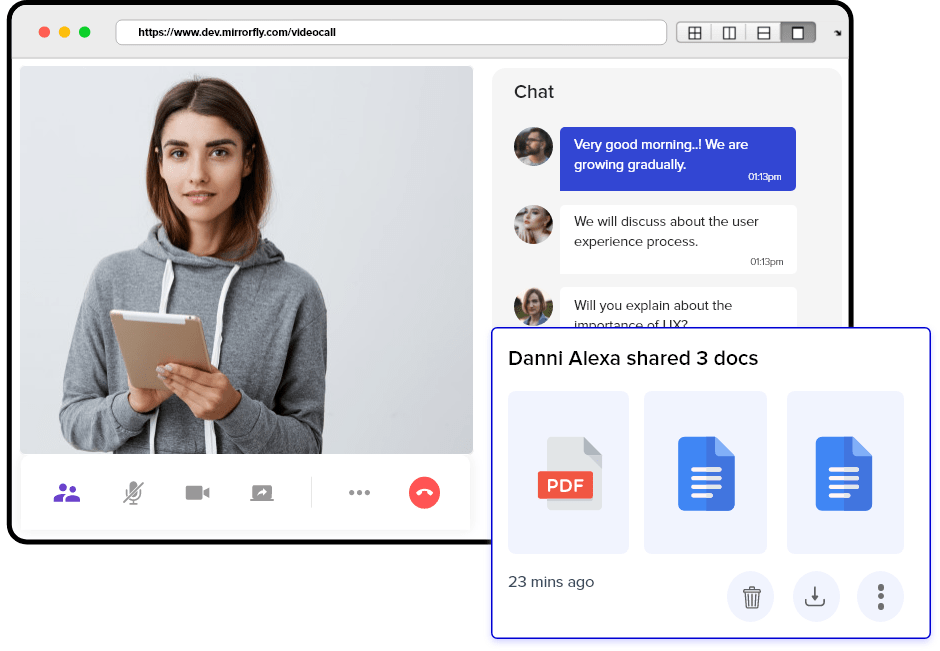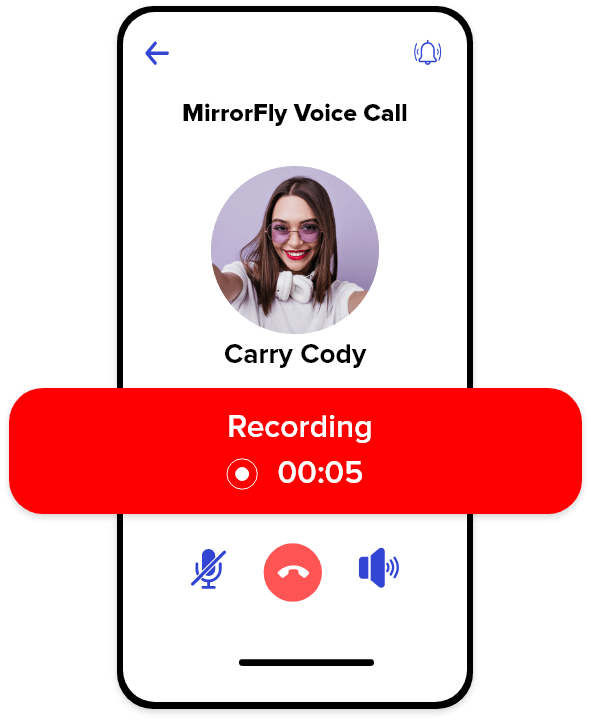How To Build a Real Time Chat App for iOS and Android?

In today’s situation, Building real-time chat apps has become a key mode of communication as it has made people aware of the importance of networking and socializing over web platforms.
According to a survey by Statista on the most popular global mobile messenger apps, about 2 billion users are accessing WhatsApp on a monthly basis for sending and receiving messages to their friends and family. This global reach and popularity have driven significant attention of app developers and upcoming enterprises resulting in a search for details to know more about building a chat platform for website and mobile apps..
This post is meant to give a stop to their search, as I have covered all the needed key aspects of how to create a real-time messaging app for mobile and web apps with features and functionalities.
Table of Contents
What is a Real-time Chat Application?
Real-time chat applications are designed to provide an interactive and responsive peer-to-peer communication experience. The messages sent are delivered and displayed immediately. This simply means that users can engage in conversations and receive updates in real-time without any significant delays.
Steps to Build a Real-time Chat App
If you are curious about building a chat app for your business, here is my take on it.
You’ve got 2 options:
Option 1: You can either build a messaging app from scratch
This option gives you complete control over your app at every step of its development. You need to code each bit of its features and take care of the security and hosting infrastructure on your own. While this sounds like a task, most developers prefer to opt for the next solution.
Option 2: Simply integrate pre-built APIs
Integrating chat APIs is the easiest way to launch messaging features into your apps within a matter of minutes. All you need to do is just create an account with trustworthy providers like MirrorFly, download their SDKs, and integrate them into your apps. Easy right? Well, let me take you through the steps it takes to build a complete chat app:
1: Create an account with MirrorFly
3: Download the SDKs you need for you Android, iOS or web apps
4: Initialize the SDKs by following API documentation
5: Add the codes for sending messages, and then to receive messages.
6: Include codes for features like building chat rooms and moderation controls
7: Connect your app and the SDK to the MirrorFly server to enable the exchange of chat messages across user devices
8: Deploy your app
That’s it! You’ve done it all within an hour. So, let’s now move on to learn more about Real-time messaging.
Outstanding Features of Real Time Messaging Applications
Well, we know that real-time chat services are built with a combination of numerous features and it’s their features and functionalities that indicate it’s growth and success in the market.
Thus, let’s have a look at some of the most popular chat app features
1. Video Calling & Video Conferencing
A real time chat app without video calling and video conferencing features is something unimaginable. This is so as these features allow you to have one-to-one video chat or – group video call interaction instantly where you can have face-to-face interaction with a wide range of global users regardless of their geographical location.

2. One-to-one and Group Chat
one-to-one and group chat enables you to connect instantly with an individual user or group of other users at once through text messaging with some special extra features like emojis, file uploading button, push notifications, contact list, chat rooms, etc., to make your in-app communication more easy and effective.

3. On-cloud & On-premise Hosting
On-cloud model makes you experience newfound enterprise-grade scalability with easy and quick installation. It is highly flexible to save time and money reducing your business’s risk.
On-premises model allows you to maintain your company’s own infrastructure and serves you for a long time with some time-consumption. On-premises chat applications are highly reliable, secure chat sdk and allows the enterprises to maintain a level of control over the app.
4. End -to End Encryption
Security is the major concern for any messaging platform. This end-to-end encryption ensures complete security over the conversation that takes place among you and others. Here, the data is encrypted at the sender’s end and will be automatically decrypted when it reaches the receiver’s end ensuring high end protection from hackers.

5. Multimedia Support (File and Image)
The real-time communication with chat, voice, and video also involves multimedia support like animation, GIFs, images, etc. The feature of multimedia support allows you to experience more interactive and fun communication with others by sending them graphics, GIFs, images, emojis, to express your emotions.

6. VoIP/SIP Calling
The main purpose of these VoIP/SIP calls is to replace your traditional business phone lines. SIP (Session Initiation Protocol) truck shares the communication path for the entire telephone network via an internet connection enabling the VoIP (Voice over Internet Protocol) services to progress. It helps businesses to establish their network by connecting with local as well as overseas businesses.
7. Voice Calling and Recording
Voice calling and voice recording are some of the best features as they connect businesses in the most cost-effective manner. They allow you to contact and interact with people in real-time wherein you can record the conversations and have them stored for your future reference.

8. Cross Platform Calling and Call Queuing
Everybody appreciates an app when it is available as an easy-to-use service. Cross-platform calling allows you to make and receive high-quality voice calls across any platform, desktop, mobile app, or carrier network anytime in realtime. With the call queuing feature, the call will automatically get into the queue until the agent gets free to attend the next call.
9. In-App Purchase and Monetization
What if you have been given the option to buy the specific features that your app desires – sounds great, right? This is what In-app purchase does, it lets users access special content within the chat app.
When it comes to monetization there are many models that assist businesses to reach out to customers in a direct way that eventually increases the conversion rate by 150% more than the conventional. For instance, in-app chat advertisements, social media ads, pay-per-download, sponsorship, premium customer service, etc.
10. Chat Analytics
Chat analytics allows you to obtain an overview of your chat performance accessing the concurrent user base, agents activity, data usage, and active users on a single dashboard in real-time. This data allows you to optimize your customer support strategy which implies improvement in its efficiency.

Now, after a brief discussion about the essential features of a realtime chat app. Let’s move on to its technical part, the backend picture.
Technical Stacks Behind a Robust Realtime Chat App
Have you ever noticed how these real time chat apps are so perfect with their functionalities? Well, it’s the technical stack that plays the key role. Yes! the one that works silently and supports the most to create a real-time chat platform at its best. Let’s explore some of the varieties in the tech stack and have a better understanding.

1. Erlang
The chief general-purpose programming language that is used to create the epic chat app like WhatsApp. Erlang has built-in support for concurrency, distribution as well as fault tolerance. This technical stack has been used in a variety of large telecommunication systems from Ericsson.
2. Ejabberd
This is an XMPP application server and an MQTT broker, which is mainly written in the Erlang programming language. It handles the message delivery system over any local area network. Ejabberd server is developed using some of the pluggable modules that enable the wide feature
- One-on-one chat
- Personal Event Protocol (PEP)
- Message typing specification
- Privacy setting and account spoofing
- Message Archive Management (MAM), and much more.
3. FreeBSD
This is a free and open-source UNIX-like operating system. It is somewhat similar to Linux, with two major differences in scope and licensing. The most popular WhatsApp which sends around a billion messages every day has built its platform on FreeBSD. Since it’s a single distributor, it has several benefits with installation with easy creation of binary packages.
4. YAWS
This YAWS (Yet Another Web Server), is fully written on Erlang. In the realtime chat applications, when these chat apps use embedded mode, the YAWS is executed as an embedded web server as with the combination, in another Erlang application. YAWS system is capable enough to handle concurrent processes in an efficient way and possesses high performance.
5. Lighttpd
Lighttpd is an open-source web server that has been optimized for speed-critical environments for higher performance. This web server is deployed on WhatsApp to obtain the most secure, flexible, fast, and compliant features. It supports the SCGI, CGI, and FastCGI interfaces to external programs, allowing the web applications to be used with the server.
Recommended Reading
6. Php
It is an open source language that has been well known for its performance and reliability. It creates a strong and powerful web development technology when combined with AJAX and displays the data from the database using AJAX to develop a responsive real-time chat app. PHP is more powerful and deep enough to run the largest social network and also easy enough to be the first server-side language for beginners.
7. BEAM
It is part of the Erlang Run-Time System (ERTS), that compiles the Erlang source code into bytecode, which is later on executed on the BEAM. In other words, we can say it is a virtual machine that runs Erlang. It is with a bunch of built-in functions like an if-simple network interface tool, etc. Its interface tools help the chat app with many functions such as Schedulers, Message passing, Processes, Memory Management, etc.
8. XMPP Server
An XMPP stands for Extensible Messaging and Presence Protocol and is an open standard that supports instant messaging as well as near-real-time chat by maintaining the exchange of XML data over a network. This XMPP server provides basic messaging, presence, and XML routing features. The real time chat app encodes the XMPP server by reducing the byte of the keywords.
9. HTML WebSocket
The WebSocket is a feature in HTML5 and a next-generation bidirectional communication technology that is meant for web applications. It is used to build a faster and more persistent connection between the web browser and the server. This WebSocket operates over a single socket and is revealed through a JavaScript Interface in an HTML5 compliant browser.
10. Mnesia DB
This is a realtime database management system that is written in the Erlang language. Since it’s a soft database, it permits the storage of messages, images, files, voice/video files, documents, GIFs, etc., on your real time chat application. This is the most forwarded technology that works beyond one’s expectations and has the capability to store any amount of data.
However, as already stated the above are some of the majorly used technologies while building a real time chat app. Now, let’s make a move pertaining to the concept of how these real time chat apps impact the operational efficiency of any business.
Impact of Real Time Chat App on Business’s Operational Efficiency
However, we cannot say that enterprises completely depend on these real time chat apps to accelerate their business. But, Of course, it does make a significant contribution to operational efficiency that supports the business in the most countable way mostly when it comes to communication. You can bring the global connection to the table by building a real time chat app for an enterprise.
Let’s see some of the major benefits it provides
Connect and Interact
The fundamental concept of any real time chat app is collaboration and communication that builds a thriving work environment and culture. With its video calling features, you can connect and have meetings with your employees as well as with business clients and have clear face-to-face communication resolving issues instantly.
This bridges the gap and also improves the client satisfaction level.

Improve Your Work Ethic
With a real time chat app your team members can create task lists and assign the task to their coworkers and tag them, and have track of it with instant notifications.
This will make your employees follow work ethics by being more aware of their next prioritized task. As a result, there will be no wastage of time which eventually improves their mindset concerning work ethics and productivity.
Productivity
Nowadays where smartphone applications are filled with many apps, they are more than enough to distract an employee from their work environment and create hindrance in their productivity. In such a case, streamlining the project processes and regular interaction with the team via real time chat app can increase productivity contributing in time management.
Simple and Cost Effective
Most of the time the business needs to connect with global clients and communicating with them over the traditional phone call is very much expensive. Instead, businesses can utilize the voice calling feature of these real time chat apps and interact with their global client for hours through an internet connection at a very minimal cost.
Security
Sharing and storage are one of the most necessary things that a real time chat app offers too with security measures. These chat apps provide several hosting options – on-cloud and on-premises as per business requirements. And provides end-to-end security over conversations and shared documents with multiple-layer security like AES 256 encryption, SSL Security, etc.
Automated Reporting Features
If any business is clearly focused on its goals, then it will mostly look for something to have a track on history and performance over the entire organization sectors, this includes individual employees, the entire team, etc.
With this, the free real time chat app provides the space to automatically record individual and team performance, on which later it generates customizable reports on a weekly or monthly basis as preferred. This in due course of time permits the employer to make decisions accordingly.
The above are some of the major contributions that the real-time chat app provides to any enterprise.
For now, I hope you would have got a clear understanding of how to make a messaging app for Android or web apps, with features, functionalities, and tech stacks.
Now, it’s up to you to decide what and all things you require to create your real time chat app for iOS , android from the above-mentioned listings. But, if you still feel you need more guidance concerning the same then feel free to contact us below, we are here to assist you.
Good Luck!
Ready To Build Your Own Custom Chat App?
Get our enterprise-grade communication solution, that can be set up on your company servers.
Request Demo100% customizable
White-label solution
Full source code

Frequently Asked Questions (FAQ)
WebRTC and Websockets are widely used in order to make a real-time chat app. To create a real-time chat app, you have to decide whether you’ll build it from scratch or use a pre-built messaging SKD. If you choose to go with the easy method, then follow the simple steps. 1. Download the SDK from the provider. 2. Integrate the real-time chat features and functionalities. 3. Connect your app to the provider’s server or host on-premise and start chatting
An example of real time chat is a conversation you have with a friend over messaging apps like Whatsapp or Slack. These apps let you communicate with others in real time via features like direct messaging and group messaging.
Building a chat app requires a combination of various tech stacks, such as those mentioned below. Frontend: React, Angular, VueJs, React Native, etc. Backend: Javascript, Node.JS, Python, Ruby, etc. Mobile apps: Kotlin, Swift, etc. Real-time engine: Websocket, WebRTC, etc. Database: MySQL, NoSQL, etc. Multiplatform: React, Flutter, React Native, Angular, etc. Hosting: AWS, Oracle, Azure, etc.
Here are a few of the real-time chat apps built using Flutter that are mentioned below. Whatsapp-clone flutter Chatter app MirrorFly API ApphiTect SDK Flutter-chat V_chat_SDK
A real-time chat API is a set of functions and procedures that acts as an interface between your app’s backend and the server infrastructure. This interface is responsible for embedding real-time messaging capabilities into your apps.
Yes. MirrorFly offers lifetime free chat SDK that comes with 150+ messaging features, 99.999% uptime SLA and an average response time below 100ms.
In a real-time messaging app, the client applications (such as web or mobile apps) communicate with the server using WebSocket or Socket.io. When a user sends a message, it is transmitted to the server and then the message is sent to the other client connected to it. The client receives the message in real-time and is displayed on the UI of the user.
Related Articles:
- How to Build a Successful Consultation App?
- 10 Best Instant Messaging Platforms for Business 2023 | MirrorFly
- Why Should You Develop Your Chat App With Flutter?
- How to Build A Custom Chat Platform: A Full Guide [2024]
hey,
how about the key features that a real-time chat solution should have for a great user experience?
Hello Kelvin,
For an optimal user experience, a real-time chat solution should prioritize quick message delivery, multimedia support, end-to-end encryption, cross-device synchronization, intuitive interface, customizable notifications, presence indicators, searchable message history, and reliable customer support. These features ensure seamless communication and enhance user engagement.
hello team,
this article was good, I’m concerned about the security of a real-time chat app. How can I ensure that the messages are secure and cannot be intercepted by malicious actors?
Hi Aswakowda,
we are pleasure to explain you thank you for your queries, Ensuring message security involves implementing end-to-end encryption, where only the communicating users can decipher the messages. Use robust encryption protocols like AES or RSA, secure data transmission via SSL/TLS, regular security audits, strong authentication methods, and secure storage practices. Regular updates and patches help mitigate vulnerabilities, ensuring a more secure messaging environment.
Hi,
Nice article could you clear me that how can I monetize a real-time messaging application once I’ve built it?
hello Senjiv,
Monetizing a real-time messaging app can be done through various avenues. Consider offering premium features like extended storage, enhanced customization, or advanced security for a subscription fee. In-app purchases for stickers, themes, or unique emojis can attract users. Advertising through targeted banners or sponsored content is another option. Additionally, you can provide enterprise solutions or APIs for businesses requiring communication tools, offering subscription-based models or pay-per-use services, diversifying revenue streams for sustained profitability.
This is such nice topic! I’ve always wanted to build a real-time chat app for iOS and Android. Can you provide some guidance on the technologies or frameworks to use for this project?
hi Egmeren,
Certainly! For real-time messaging, consider using WebSocket for instant data transfer. Frameworks like Socket.IO or SignalR offer efficient WebSocket implementations. For app development, React Native or Flutter provide cross-platform compatibility. Backend systems can leverage Node.js, Django, or Firebase for scalability and real-time functionality.
Could you clear me that Which kind of technologies are commonly used to build real-time chat apps?
Commonly used technologies for building real-time chat apps include Firebase for real-time databases, WebSocket for bidirectional communication, and frameworks like React Native or Flutter for cross-platform development, alongside various programming languages.
Hi,
I just went through your article that was pretty nice, here I have a doubt that How do I ensure real-time functionality? if possible explain me it might be helpfull.
To ensure real-time functionality in your chat app, you should focus on these key elements:
Use a Real-Time Database: Employ a real-time database like Firebase or implement WebSockets to instantly update and synchronize data across all clients.
Optimize Network Efficiency: Minimize data transfer by sending only relevant updates and use efficient data structures to reduce latency.
Push Notifications: Implement push notifications to alert users about new messages or updates, even when the app is in the background.
Server-Side Scaling: Ensure your server infrastructure can handle the real-time demands of your app by scaling resources as needed.
Client-Side Responsiveness: Use asynchronous programming techniques to keep the user interface responsive and prevent freezing during data updates.
I think this is one of the best article about building android & ios real-time messaging app that I’m looking for. Thanks for sharing this article.
Hi Dev,
Thank you for your complement.
Thanks. I found a some good ideas in your article and building the awesome realtime chat solution for both iOS & Android mobile app.
Your article helped me a lot, is there any more related content? Thanks!
Yes Konto,
You can check with our blog hope you can find some more useful topics as you expected. you can free to contact us.